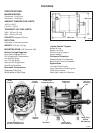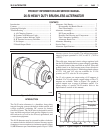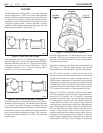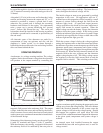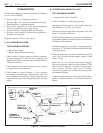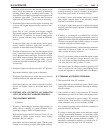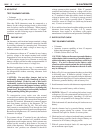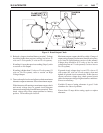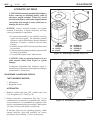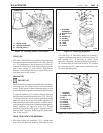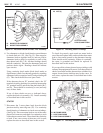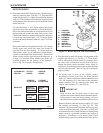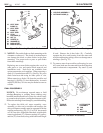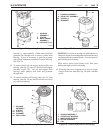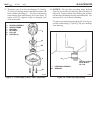
26-SI ALTERNATOR
1G/287 4/96
PAGE
- If indicator light does not come on with jumper lead in
place, verify that alternator is properly grounded by
touching jumper lead to another ground source. If
lamp still does not light, locate and correct open circuit
in indicator light circuit. Circuit fuse may be open or
light bulb may be burned out. Correct as necessary.
3. If indicator light comes on while engine is running, but
is not on with engine stopped and key switch in “run”
position:
Leave key in “run” position with engine stopped.
Disconnect indicator light lead from alternator. This
will be at the “I” terminal. Use fused (5-amp) jumper
lead to ground indicator lamp circuit to alternator
housing.
- If indicator light comes on with jumper lead in place,
replace internal indicator light lead assembly or
regulator as described under Unit Repair.
- If indicator light does not come on with jumper lead in
place, locate and correct open circuit in indicator light
circuit between battery and light. Circuit fuse may be
open. (With engine running, light is being powered by
alternator and grounded through other circuits
connected in parallel to indicator light circuit.) Correct
as necessary.
4. If indicator light is on with key switch in “off” position:
Disconnect indicator light circuit at alternator.
- If indicator light remains on, locate and correct shorted
condition between the light and alternator.
- If indicator light goes out, diode is shorted in rectifier.
Locate and replace diode as described under Unit
Repair.
C. SYSTEMS WITH VOLTMETER, NO INDICATOR
LIGHT, OR WITH LIGHT WORKING PROPERLY -
TEST EQUIPMENT NEEDED:
• Voltmeter
1. If battery is undercharged, indicator light remains on
while vehicle is running, or system voltmeter shows
operating voltage is below acceptable range:
With engine stopped and all electrical loads off, use
voltmeter to check system voltage across battery
terminals. Record voltage.
Start engine and run at moderate speed. Check system
voltage across battery terminals with engine running.
- If voltage reading at battery terminals is different from
reading showing at system voltmeter (if equipped),
locate and correct cause of incorrect reading.
- If voltage is lower than reading previously recorded
with engine stopped, there is no alternator output.
Proceed to section on No Output.
- If voltage is higher than previous reading with engine
stopped, alternator output is present. Proceed to Rated
Output Check.
2. If battery is overcharged (as evidenced by excessive
water use or electrolyte spewing from battery vents), or
light bulbs or other electrical equipment have shortened
life due to suspected high system voltage, or system
voltmeter reads above normal range:
With fully charged battery, engine running at moderate
speed and all electrical loads off, use voltmeter to
check voltage at battery terminals.
For a 12-volt system, readings should be stable, around
13.5 - 14.5 volts and in no case go above 15 volts. For
a 24-volt system, readings should be stable, around 27
- 28 volts and in no case go above 31 volts.
- One-wire system: If voltage is erratic or goes above 15
volts (31 volts on 24-volt system), check internal sense
circuit and regulator as described under Unit Repair.
D. R TERMINAL ACCESSORY PROBLEMS
1. Disconnect lead from “R” terminal.
2. Start engine and run at moderate speed. Check system
voltage across battery terminals with engine running.
Record voltage.
3. Use voltmeter to check voltage between “R” terminal
and alternator ground screw or other clean metal ground.
- If voltage is near half of system voltage, “R” terminal
output is O.K. Note that this is a pulsating signal, so
some voltmeters may give an unsteady reading.
- If no voltage is present, replace diode trio assembly as
described under Unit Repair.
- If voltage is nearly the same as the alternator output
voltage, disassemble alternator as described under
Unit Repair and check to see if terminal is connected to
diode trio lead. If so, replace diode trio assembly. If
terminal is connected to regulator, it is wired as an “I"
terminal and can’t be used as an “R” terminal.
5




